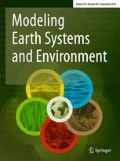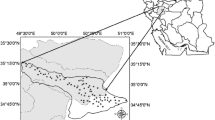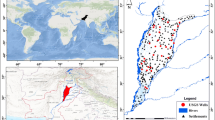Abstract
Groundwater is the main water resource which supplies more than half of the residents of Afram Plains. Recent studies show that the aquifer is subject to deteriorating quality from several anthropogenic activities. The aquifer vulnerability to contamination was assessed using the widely known DRASTIC model. This paper aimed to determine the depth-to-water table, identification of the various soil types, topography, recharge rate, and major lithological units in the area. The degree of vulnerability was identified by an index which is computed by superimposition of all the parameters considered for the model. Based on the vulnerability assessment, it was found that, 20.72% (1044.28 km2), 49.78% (2508.91 km2) and 29.50% (1486.80 km2) of the total area was classified as low, moderate and high, respectively. The final vulnerability index was largely influenced by the depth-to-water table, impact of the vadose zone, net recharge and aquifer media parameters. The model was validated with on-ground nitrate concentrations in groundwater in the study area. The DRASTIC model exhibits highly correlated areas in mapping vulnerable regions. The maps produced in this study could be used as a general guide to vulnerability by planners, groundwater managers and decision-makers on the implementation of measures aimed at the protection of this vulnerable resource.



Source: Davies (2002)















Similar content being viewed by others
References
Added A, Hamza MH (2000) Evaluation of the vulnerability to pollution in Metline aquifer (North-East of Tunisia). Mater Thesis, University of Tunis II, Geologic Department, Tunisia
Akhavan S, Mousavi S-F, Abedi-Koupai J, Abbaspour KC (2011) Conditioning DRASTIC model to simulate nitrate pollution case study: Hamadan–Bahar plain. Environ Earth Sci 63(6):1155–1167
Al Hallaq AH, Elaish BSA (2012) Assessment of aquifer vulnerability to contamination in Khanyounis Governorate, Gaza Strip—Palestine, using the DRASTIC model within GIS environment. Arabian J Geosci 5(4):833–847
Al Kuisi M, El-Naqa A, Hammouri N (2006) Vulnerability mapping of shallow groundwater aquifer using SINTACS model in the Jordan Valley area, Jordan. Environ Geol 50(5):651–667
Al-Adamat RAN, Foster IDL, Baban SMJ (2003) Groundwater vulnerability and risk mapping for the Basaltic aquifer of the Azraq basin of Jordan using GIS, Remote sensing and DRASTIC. Appl Geogr 23(4):303–324. doi:10.1016/j.apgeog.2003.08.007
Aller L, Bennett T, Lehr JH, Petty RJ, Hackett G (1987). DRASTIC: a standardized method for evaluating ground water pollution potential using hydrogeologic settings. NWWA/Epa-600/2-87-035, 455
Alwathaf Y, El Mansouri B (2011) Assessment of aquifer vulnerability based on GIS and ARCGIS methods: a case study of the Sana’a Basin (Yemen). J Water Resour Prot 3(12):845
Arzu Firat E, Fatma G (2013) DRASTIC-based methodology for assessing groundwater vulnerability in the Gümüshaciköy and Merzifon basin (Amasya, Turkey). Earth Sci Res J 17(1):33–40
Awotwi A, Kumi M, Jansson PE, Yeboah F, Nti IK (2015) Predicting hydrological response to climate change in the White Volta catchment, West Africa. J Earth Sci Clim Change 6(1):1–7
Baalousha H (2006) Vulnerability assessment for the Gaza Strip, Palestine using DRASTIC. Environ Geol 50(3):405–414
Babiker IS, Mohamed MAA, Hiyama T, Kato K (2005) A GIS-based DRASTIC model for assessing aquifer vulnerability in Kakamigahara Heights, Gifu Prefecture, central Japan. Sci Total Environ 345(1–3):127–140. doi:10.1016/j.scitotenv.2004.11.005
Bazimenyera JDD, Zhonghua T (2008) A GIS based DRASTIC model for assessing groundwater vulnerability in shallow aquifer in Hangzhou-Jiaxing-Huzhou Plain, China. Res J Appl Sci 3(8):550–559
Chitsazan M, Akhtari Y (2009) A GIS-based DRASTIC model for assessing aquifer vulnerability in Kherran Plain, Khuzestan, Iran. Water Resour Manage 23(6):1137–1155
Civita M, De Maio M (2000) SINTACS R5 a new parametric system for the assessment and automatic mapping of groundwater vulnerability to contamination. Publ. No. 2200 Del GNDCI-CNR Pitagora Editrice, Bologna, p 240
Ckakraborty S, Paul PK, Sikdar PK (2007) Assessing aquifer vulnerability to arsenic pollution using DRASTIC and GIS of North Bengal Plain: a case study of English Bazar Block, Malda District, West Bengal, India. J Spat Hydr, 7(1)
Davies J (2002) Low permeability rocks in sub-Saharan Africa: visit to Ghana to disseminate project results, 16–23 March 2002
Doerfliger N, Jeannin P-Y, Zwahlen F (1999) Water vulnerability assessment in karst environments: a new method of defining protection areas using a multi-attribute approach and GIS tools (EPIK method). Environ Geol 39(2):165–176. doi:10.1007/s002540050446
Foster SSD (1987) Fundamental concepts in aquifer vulnerability, pollution risk and protection strategy. Vulnerability Soil Groundw Pollut 38:69–86
Gleeson T, Smith L, Moosdorf N, Hartmann J, Dürr HH, Manning AH, Jellinek AM (2011). Mapping permeability over the surface of the Earth. Geophys Res Lett 38(2)
Goldscheider N, Klute M, Sturm S, Hötzl H (2000) The PI method—a GIS-based approach to mapping groundwater vulnerability with special consideration of karst aquifers. Z Angew Geol 46(3):157–166
Hartmann J, Moosdorf N (2012). The new global lithological map database GLiM: a representation of rock properties at the Earth surface. Geochem Geophys Geosyst, 13(12)
Hasiniaina F, Zhou J, Guoyi L (2010) Regional assessment of groundwater vulnerability in Tamtsag basin, Mongolia using drastic model. J Am Sci 6(11):65–78
Hengl T, de Jesus JM, MacMillan RA, Batjes NH, Heuvelink G. B. M., Ribeiro E, Walsh MG (2014). Soil Grids 1 km—global soil information based on automated mapping. PLoS One 9(8):e105992
Herlinger R Jr, Viero AP (2006) Evaluation of contaminants retention in soils from Viamao District, Rio Grande do Sul State, Brazil. Environ Geol 50(1):47–54
Jha MK, Sebastian J (2005) Vulnerability study of pollution upon shallow groundwater using Drastic/GIS. In: A paper presented in the 8th Annual International Conference and Exhibition in India, Map India. Geomatics, New Delhi, India
Kabera T, Zhaohui L (2008) A GIS based DRASTIC model for assessing groundwater in shallow aquifer in Yuncheng Basin, Shanxi, China. Res J Appl Sci 3(3):195–205
Kim YJ, Hamm S-Y (1999) Assessment of the potential for groundwater contamination using the DRASTIC/EGIS technique, Cheongju area, South Korea. Hydrogeol J 7(2):227–235
Krishna R, Iqbal J, Gorai AK, Pathak G, Tuluri F, Tchounwou PB (2015) Groundwater vulnerability to pollution mapping of Ranchi district using GIS. Appl Water Sci 5(4):345–358
Kwansiririkul K, Singharajwarapan FS, Mackay R, Ramingwong T, Wongpornchai P (2004) Vulnerability assessment of groundwater resources in the Lampang Basin of Northern Thailand. J Environ Hydrol 12(23):1–15
Leal J. A. R., Castillo RR (2003) Aquifer vulnerability mapping in the Turbio river valley, Mexico: a validation study. Geofísica Int 42(1):141–156
Lee S (2003) Evaluation of waste disposal site using the DRASTIC system in Southern Korea. Environ Geol 44(6):654–664
Liggett JE, Talwar S (2009) Groundwater Vulnerability Assessments and Integrated Water Resource Management. Streamline Watershed Manag Bull 13(1):18–29
Lobo-Ferreira JP, Oliveira M (1997) Drastic groundwater vulnerability mapping of Portugal. Groundwater: an endangered resource. ASCE, pp 132–137
Margat J (1968) Contamination vulnerability mapping of groundwater. Bureau de Recherches Geologiques et Minieres, Orleans
Murat V, Rivera A, Pouliot J, Miranda-Salas M, Savard MM (2004) Aquifer vulnerability mapping and GIS: a proposal to monitor uncertainty associated with spatial data processing. Geofís Int 43(4):551–565
Olorunfemi MO, Ojo JS, Akintunde OM (1999) Hydro-geophysical evaluation of the groundwater potentials of the Akure metropolis, Southwestern Nigeria. J Min Geol 35(2):207–228
Ouedraogo I, Defourny P, Vanclooster M (2016) Mapping the groundwater vulnerability for pollution at the pan African scale. Sci Total Environ 544:939–953. doi:10.1016/j.scitotenv.2015.11.135
Piscopo G (2001). Groundwater vulnerability map explanatory notes—Castlereagh Catchment. Australia NSW Department of Land and Water Conservation, Parramatta
Rahman A (2008) A GIS based DRASTIC model for assessing groundwater vulnerability in shallow aquifer in Aligarh, India. Appl Geogr 28(1):32–53. doi:10.1016/j.apgeog.2007.07.008
Samake M, Tang Z, Hlaing W, Innocent N, Kasereka K, Balogun WO (2011) Groundwater vulnerability assessment in shallow aquifer in Linfen Basin, Shanxi Province, China using DRASTIC model. J Sustain Develop 4(1):53
Secunda S (1998) Groundwater vulnerability assessment using a composite model combining DRASTIC with extensive agricultural land use in Israel’s Sharon region. J Environ Manage 54(1):39–57. doi:10.1006/jema.1998.0221
Sener E, Sener S, Davraz A (2009) Assessment of aquifer vulnerability based on GIS and DRASTIC methods: a case study of the Senirkent-Uluborlu Basin (Isparta, Turkey). Hydrogeol J 17(8):2023–2035. doi:10.1007/s10040-009-0497-0
Shirazi SMM, Imran HMM, Akib S (2012) GIS-based DRASTIC method for groundwater vulnerability assessment: a review. J Risk Res 15(8):991–1011. doi:10.1080/13669877.2012.686053
Shirazi SM, Imran HM, Akib S, Yusop Z, Harun ZB (2013) Groundwater vulnerability assessment in the Melaka State of Malaysia using DRASTIC and GIS techniques. Environ Earth Sci 70(5):2293–2304
Stempvoort D, Van Ewert L, Wassenaar L (1993). Aquifer vulnerability index: a gis—compatible method for groundwater vulnerability mapping. Can Water Resour J 18(1):25–37. doi:10.4296/cwrj1801025
Stigter TY, Ribeiro L, Dill AMMC (2006) Evaluation of an intrinsic and a specific vulnerability assessment method in comparison with groundwater salinisation and nitrate contamination levels in two agricultural regions in the south of Portugal. Hydrogeol J 14(1–2):79–99
Thirumalaivasan D, Karmegam M, Venugopal K (2003) AHP-DRASTIC: software for specific aquifer vulnerability assessment using DRASTIC model and GIS. Environ Modell Softw 18:645–656. doi:10.1016/S1364-8152(03)00051-3
Tsoy I (2015). Groundwater vulnerability assessment for railroad construction in Stockholm, Sweden, using Spatial Multi Criteria Analysis
Varol SO, Davraz A (2010) Hydrogeological investigation of Sarkikaraagac Basin (Isparta, Turkey) and groundwater vulnerability. Water Int 35(2):177–194
Vias JM, Andreo B, Perles MJ, Carrasco F (2005) A comparative study of four schemes for groundwater vulnerability mapping in a diffuse flow carbonate aquifer under Mediterranean climatic conditions. Environ Geol 47(4):586–595
Vías JM, Andreo B, Perles MJ, Carrasco F, Vadillo I, Jiménez P (2006) Proposed method for groundwater vulnerability mapping in carbonate (karstic) aquifers: the COP method. Hydrogeol J 14(6):912–925
Vrba J, Zaporozec A (1994). Guidebook on mapping groundwater vulnerability. Hannover: Heise. Internation Association of Hydrogeologists, 16
Water Framework Directive (WFD) (2000) Directive 2000/60/EC of the European Parliament and of the Council establishing a framework for community action in the field of water policy. Off J Eur Commu L:327/1
Acknowledgements
This study was conducted within the framework of an MSc. This study was funded by the Regional Water and Environmental Sanitation Centre, Kumasi (RWESCK) at Kwame Nkrumah University of Science and Technology, Kumasi with funding from Ghana Government and the World Bank under the Africa Centre’s of Excellence Project. The views expressed in this paper do not reflect those of the World Bank, Ghana Government and KNUST. Special thanks are given to A. Y. Modoc, Director of Afram Plains Development Organization (APDO), Patrick Nyarko and Issoufou Ouedraogo, for providing a great deal of the data used in this research.
Author information
Authors and Affiliations
Corresponding author
Rights and permissions
About this article
Cite this article
Agyare, A., Anornu, G.K. & Kabo-bah, A.T. Assessing the vulnerability of aquifer systems in the Volta river basin: a case-study on Afram Plains, Ghana. Model. Earth Syst. Environ. 3, 1141–1159 (2017). https://doi.org/10.1007/s40808-017-0363-3
Received:
Accepted:
Published:
Issue Date:
DOI: https://doi.org/10.1007/s40808-017-0363-3




